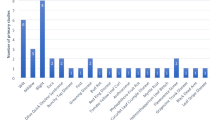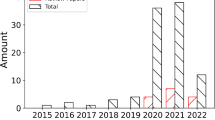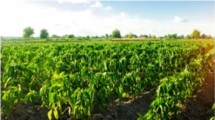Abstract
The Internet of Things (IoT) has grown more importance in agriculture production, as it helps to observe and store up information in a large environment. The plant leaf disease condenses the quantity and quality of agricultural products. Hence, the farmer needs to find and discover the plant disease at the beginning stage. The plant disease can be present in any part, like leaves, fruits and stems. Therefore, it is an important research area to detect plant disease automatically to reduce economic or production loss. Without appropriate classification of the disease and the disease-causing mediator, the disease control process can be a waste of time and money and can lead to additional plant losses. This research developed a method named Taylor Student Psychology Based Optimization integrated Deep Q network (TSPBO-based DQN) to detect plant disease in IoT simulated system atmosphere. The nodes are randomly dispersed in the system area to collect plant images. The captured images are routed to the sink node to complete the proposed method's disease recognition scheme. The proposed method is highly efficient in classifying the plant diseases and has shown outstanding performance by acquiring high accuracy, sensitivity, specificity and remaining energy.









Similar content being viewed by others
Abbreviations
- IoT:
-
Internet of Things
- TSPBO-based DQN:
-
Taylor student psychology based optimization integrated deep Q network
- SVM:
-
Support vector machine
- ANN:
-
Artificial neural network
- RF:
-
Random forest
- KNN:
-
K nearest neighbour
- FLD:
-
Fisher linear discriminant
- SIFT:
-
Scale invariant feature transform
- CNN:
-
Convolutional neural network
- LTP:
-
Local ternary pattern
- SLIF:
-
Spider local image feature
- SPBO:
-
Student psychology based optimization algorithm
- EEG:
-
Energy-efficient geographic
- ResNet:
-
Residual neural network
- GLCM:
-
Grey-level co-occurrence matrix
- BS:
-
Base station
- R-CNN:
-
Region-based CNN
- ROI:
-
Region of interest
- SCA based RideNN:
-
Sine cosine algorithm based rider neural network
References
Mishra, M., Choudhury, P., & Pati, B. (2021). Modified ride-NN optimizer for the IoT based plant disease detection. Journal of Ambient Intelligence and Humanized Computing, 12, 691–703.
Reddy, P. K., & Rajasekhara Babu, M. (2019). Cluster head selection in IoT using enhanced self adaptive bat algorithm. Journal of Networking and Communication Systems (JNACS), 2(4), 23–32.
Dhumane, A. V., Markande, S. D., & Midhunchakkaravarthy, D. (2020). Multipath transmission in IoT using hybrid salp swarm-differential evolution algorithm. Journal of Networking and Communication Systems, 3(1), 20–30.
Anandkumar, M. (2020). Multicast routing in WSN using bat algorithm with genetic operators for IoT applications. Journal of Networking and Communication Systems, 3(2), 1–8.
Wang, X. F., Wang, Z., Zhang, S. W., & Shi, Y. (2015). Monitoring and discrimination of plant disease and insect pests based on agricultural IOT. In 4th International Conference on Information Technology and Management Innovation (pp. 112–115). Atlantis Press.
Sabrol, H., & Satish, K. (2016). Tomato plant disease classification in digital images using classification tree. In 2016 International Conference on Communication and Signal Processing (ICCSP) (pp. 1242–1246).
Esgario, J. G., Krohling, R. A., & Ventura, J. A. (2020). Deep learning for classification and severity estimation of coffee leaf biotic stress. Computers and Electronics in Agriculture, 169, 105162.
Ebrahimi, M. A., Khoshtaghaza, M. H., Minaei, S., & Jamshidi, B. (2017). Vision-based pest detection based on SVM classification method. Computers and Electronics in Agriculture, 137, 52–58. https://doi.org/10.1016/j.compag.2017.03.016
Deepa, S., & Umarani, R. (2017). Steganalysis on Images using SVM with Selected Hybrid Features of Gini Index Feature Selection Algorithm. International Journal of Advanced Research in Computer Science, 8(5).
Guettari, N., Capelle-Laizé, A. S., & Carré, P. (2016). Blind image steganalysis based on evidential k-nearest neighbors. In: IEEE (pp. 2742–2746). Phoenix.
Chen, J., Chen, J., Zhang, D., Sun, Y., & Nanehkaran, Y. A. (2020). Using deep transfer learning for image-based plant disease identification. Computers and Electronics in Agriculture, 173, 105393.
Kadir, A. (2014). A model of plant identification system using GLCM, lacunarity and shen features. Research Journal of Pharmaceutical, Biological, and Chemical Sciences, 5(2), 1–10.
Naik, M. R., & Sivappagari, C. (2016). Plant Leaf and Disease Detection by using HSV features and SVM. IJESC, 6(12).
Golhani, K., Balasundram, S. K., Vadamalai, G., & Pradhan, B. (2018). A review of neural networks in plant disease detection using hyperspectral data. Information Processing in Agriculture, 5, 354–371.
Hameed, A. R., Ul Islam, S., Raza, M., & Khattak, H. A. (2020). Towards energy and performance-aware geographic routing for IoT-enabled sensor networks. Computers & Electrical Engineering, 85, 106643.
Deeba, K., & Amutha, B. (2020). ResNet-deep neural network architecture for leaf disease classification. Microprocessors and Microsystems, 103364.
Ozguven, M. M., & Adem, K. (2019). Automatic detection and classification of leaf spot disease in sugar beet using deep learning algorithms. Physica A: Statistical Mechanics and its Applications, 535, 122537.
Shrivastava, V. K., & Pradhan, M. K. (2021). Rice plant disease classification using color features: A machine learning paradigm. Journal of Plant Pathology, 103(1), 17–26.
Waheed, A., Goyal, M., Gupta, D., Khanna, A., Hassanien, A. E., & Pandey, H. M. (2020). An optimized dense convolutional neural network model for disease recognition and classification in corn leaf. Computers and Electronics in Agriculture, 175, 105456.
Hernández, S., & Lopez, J. L. (2020). Uncertainty quantification for plant disease detection using Bayesian deep learning. Applied Soft Computing, 96.
Argüeso, D., Picon, A., Irusta, U., Medela, A., San-Emeterio, M. G., Bereciartua, A., & Alvarez-Gila, A. (2020). Few-shot learning approach for plant disease classification using images taken in the field. Computers and Electronics in Agriculture, 175.
Nguyen, T. D., Khan, J. Y., & Ngo, D. T. (2017). An effective energy-harvesting-aware routing algorithm for WSN-based IoT applications. Journal of Emerging Technologies and Innovative Research, 6(3), 460–469.
Chen, Z., He, M., Liang, W., & Chen, K. (2015). Trust-aware and low energy consumption security topology protocol of wireless sensor network. Journal of Sensors.
Mangai, S. A., Sankar, B. R., & Alagarsamy, K. (2014). Taylor series prediction of time series data with error propagated by artificial neural network. International Journal of Computer Applications, 89(1).
Das, B., Mukherjee, V., & Das, D. (2020). Student psychology based optimization algorithm: A new population based optimization algorithm for solving optimization problems. Advances in Engineering Software, 146, 102804.
Löfstedt, T., Brynolfsson, P., Asklund, T., Nyholm, T., & Garpebring, A. (2019). Gray-level invariant Haralick texture features. PLoS One, 14(2), e0212110.
Freitas, P. G., Akamine, W. Y., & Farias, M. C. (2016). No-reference image quality assessment based on statistics of local ternary pattern. In: 2016 Eighth International Conference on Quality of Multimedia Experience (QoMEX) (pp. 1–6).
Tan, X., & Triggs, B. (2010). Enhanced local texture feature sets for face recognition under difficult lighting conditions. IEEE Transactions on Image Processing, 19(6), 1635–1650.
Fausto, F., Cuevas, E., & Pérez-Cisneros, M. (2016, November). An optimization based approach for maximizing the information content of keypoints detected on a digital image. In: Proceedings of the sixteenth mexican international conference on computer science (pp. 1–5).
Wang, Y., Liu, H., Zheng, W., Xia, Y., Li, Y., Chen, P., Guo, K., & Xie, H. (2019). Multi-objective workflow scheduling with deep-Q-network-based multi-agent reinforcement learning. IEEE Access, 7, 39974–39982.
Rice Leaf Diseases Data Set, https://archive.ics.uci.edu/ml/datasets/Rice+Leaf+Diseases, Accessed on July 2021.
Image set for deep learning, https://www.ncbi.nlm.nih.gov/pmc/articles/PMC6030791/, Accessed on July 2021.
Serhani, A., Naja, N., & Jamali, A. (2020). AQ-Routing: Mobility-, stability-aware adaptive routing protocol for data routing in MANET–IoT systems. Cluster Computing, 23(1), 13–27.
Gedminas, A., Duoba, L., & Navakauskas, D. (2020). P system framework for Ant Colony algorithm in IoT data routing. International Journal of Advanced Computer Science and Applications, 11(4), 28–34.
Farahani, B., Barzegari, M., Aliee, F. S., & Shaik, K. A. (2020). Towards collaborative intelligent IoT eHealth: From device to fog, and cloud. Microprocessors and Microsystems, 72, 102938.
Ciuonzo, D., Rossi, P. S., & Varshney, P. K. (2021). Distributed detection in wireless sensor networks under multiplicative fading via generalized score tests. IEEE Internet of Things Journal, 8(11), 9059–9071.
Darvishi, H., Ciuonzo, D., Eide, E. R., & Rossi, P. S. (2021). Sensor-fault detection, isolation and accommodation for digital twins via modular data-driven architecture. IEEE Sensors Journal, 21(4), 4827–4838.
Author information
Authors and Affiliations
Corresponding author
Additional information
Publisher's Note
Springer Nature remains neutral with regard to jurisdictional claims in published maps and institutional affiliations.
Rights and permissions
Springer Nature or its licensor (e.g. a society or other partner) holds exclusive rights to this article under a publishing agreement with the author(s) or other rightsholder(s); author self-archiving of the accepted manuscript version of this article is solely governed by the terms of such publishing agreement and applicable law.
About this article
Cite this article
Vimala, S., Madhusudhana Rao, T.V., Balaji, A. et al. Taylor-student psychology based optimization integrated deep learning in IoT application for plant disease classification. Wireless Netw 29, 919–939 (2023). https://doi.org/10.1007/s11276-022-03150-2
Accepted:
Published:
Issue Date:
DOI: https://doi.org/10.1007/s11276-022-03150-2




